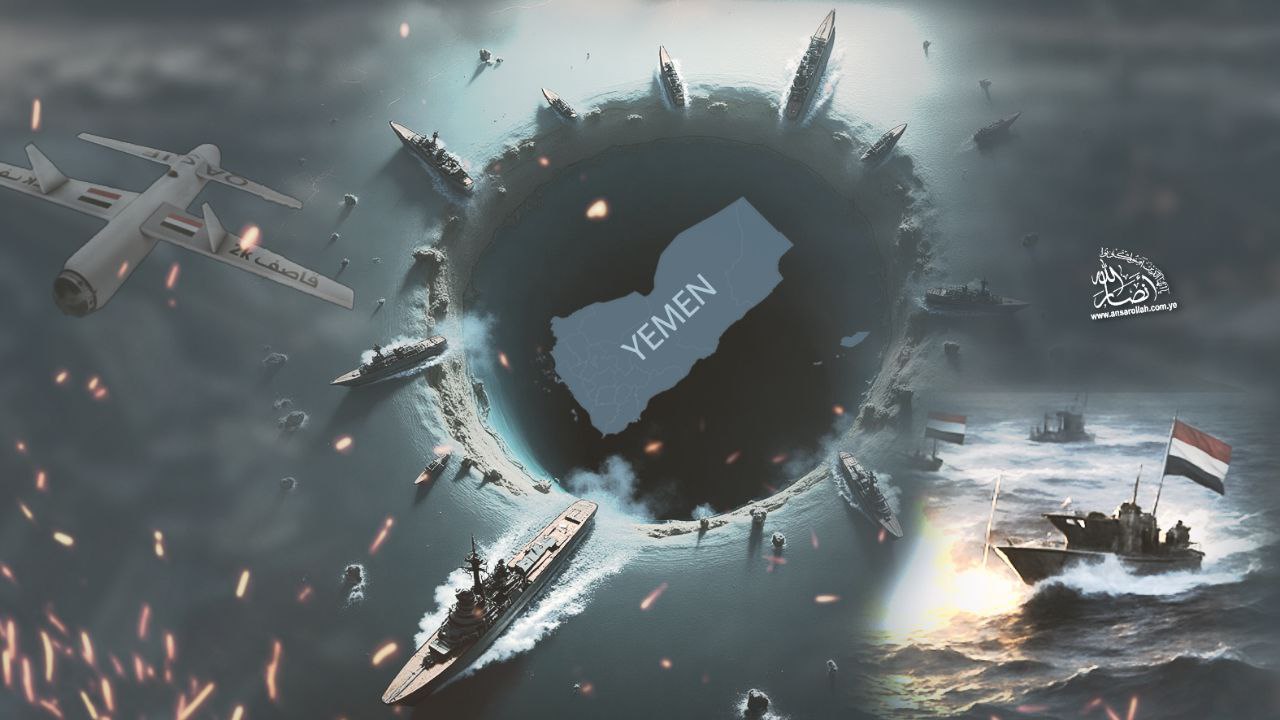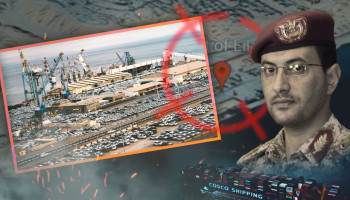Ansarollah Website. Report |
The region has witnessed a dramatic shift in the balance of naval power, as the Yemeni naval forces have succeeded in imposing a new reality on shipping to and from the Israeli entity in the occupied territories. The sea lanes, once considered a vital artery for economic and military purposes, have become the stage for qualitative operations that have turned the tables on the Zionist entity. This development has become the talk of international forums, and analysts consider it a declaration of a new phase in which the rules of the game are changing.
Repeated strikes by the Yemeni naval forces, missile forces, and drones in the Red Sea, Bab al-Mandab, the Gulf of Aden, and all the way to the Indian Ocean have proven that Israeli shipping, and shipping linked to the entity, is no longer immune to attack. This reality has prompted many international shipping companies to reroute their routes, avoiding the risks of transiting waters long considered safe. The port of Eilat, once a vital gateway to the Red Sea and the Far East, is now facing a severe economic crisis with its traffic declining and resulting in its complete closure.
Amid these developments, the equation of aggression, upon which Israel has long relied to impose its regional hegemony, is rapidly eroding. The Yemeni escalation not only threatens Israeli navigation, but also sends a clear message that the rules of engagement have changed, and that the military and economic price of any Zionist adventures has become extremely high. Moreover, these rapid developments place the region at a crossroads, where the hegemonic powers can no longer ignore Yemen's growing role in shaping the maritime security landscape, redefining the concept of power and influence in this vital corner of the world.
The Red Sea: A Strategic Arena for the Emergence of a New Deterrence Reality
The Red Sea is a vital artery for global trade, linking the Mediterranean Sea to the Indian Ocean. This region has witnessed a radical shift in the geopolitical landscape since November 2023, with the escalation of Yemeni Armed Forces operations against commercial shipping bound for the Zionist entity.
The Yemeni Armed Forces began targeting ships linked to the Israeli enemy in the Red Sea in November 2023, expressing solidarity with the Palestinian people and in response to the Zionist aggression against Gaza.
The virtual paralysis of the Israeli port of Eilat—a vital strategic outlet on the Red Sea—has become the most prominent evidence of the success of this equation. According to Hebrew media reports, this paralysis represents a strategic victory for the Yemeni Armed Forces and a profound economic and psychological blow to the Zionist entity. The repercussions were not limited to one port, but extended to include increased shipping costs, extended transit times, and significant inflationary pressures. These repercussions, as Western economic experts analyze, have strengthened Yemen's influence and created indirect international pressures that support its deterrent goals.
The Deterrence Equation: A Tactical Response to Support Gaza
The successful disruption of Israeli maritime trade, the virtual paralysis of the strategic port of Eilat, and even the disruption of air traffic at Lod Airport are prime examples of this equation, demonstrating the Yemeni armed forces' ability to project power and impose costs beyond their immediate borders. Analysts at American think tanks point out that the "deterrence equation" imposed by the Yemenis is a tactical response to support Gaza, one that ends when its goal of halting Israeli aggression is achieved. At the same time, it is a strategic maneuver within broader, longer-term regional ambitions.
This means—according to Pentagon estimates—that even if the conflict in Gaza subsides, the Yemeni threat to shipping bound for Israel may persist, with the continuation of genocide and occupation crimes. Moreover, it serves fundamental ideological goals, represented by the regional challenge and the growing Western influence in plundering the nation's wealth, weakening its decisions and sovereignty over its lands and resources. Therefore, the "deterrence" sought by the Yemenis relates to a fundamental shift in the regional balance of power, ending the Zionist presence and international hegemony in the region.
This dynamic highlights a crucial shift in modern conflicts, as Western military experts see it: conventional military superiority does not automatically translate into effective deterrence against agile, ideologically driven non-state actors operating in complex geopolitical environments. The Yemenis are imposing economic turmoil within Israel as a primary deterrent, forcing the Zionist entity to incur heavy costs, paving the way for a major military confrontation to liberate the occupied territories and end the Israeli occupation of Arab lands. This challenges traditional concepts of deterrence, which often focus on mutual military capabilities, and emphasizes the effectiveness of economic warfare in asymmetric contexts. The "deterrence equation" here, according to an analysis by the American Rand Corporation, "is less about mutually assured destruction and more about economic strangulation and strategic embarrassment."
The Economic Pillar of Eilat Port Blockade
The direct economic impact of the Yemeni Armed Forces' operations against the Zionist entity is clearly evident in the port of Eilat, which has become a tangible symbol of the imposed "deterrence equation." On both the operational and financial levels, the port of Eilat (the Zionist entity's southern gateway to the occupied territories) was permanently closed on July 20, 2025, due to the financial collapse directly caused by the Yemeni military operations in the Red Sea.
The port has experienced a staggering decline of more than 90% in its activity since the Yemeni Armed Forces began their attacks on ships in November 2023, according to data published by the Hebrew newspaper Yedioth Ahronoth. This significant drop in shipping volumes, combined with ongoing operational costs (such as municipal taxes and salary costs), has led to the accumulation of debts exceeding $20 million, making continued operations financially unsustainable by mid-2025. This financial crisis directly threatens 170 jobs. The port declared bankruptcy in July and requested official government support. However, even the minimum promised "government" aid of NIS 15 million ($4.5 million) has not been received. A total closure of the port was announced on July 20, 2025.
As for the impact on Israeli trade, supply chains, and key sectors, Eilat is a critical entry point for certain imports from East Asia, receiving approximately 50% of Israel's vehicle imports from China, according to the Hebrew business newspaper Globes. Its closure directly impacts these supply chains.
The port is also a vital gateway for exports to the Far East, particularly for phosphates and potash from Israel Chemicals Ltd. (ICL). This disruption impacts key Israeli industries. The broader economic repercussions for Israel include higher import costs and significant challenges for exporters, particularly for perishable goods that cannot withstand long transit times. Ships bound for Israel from the Far East are now forced to reroute around the southern tip of Africa (the Cape of Good Hope), adding two to four weeks to shipping times and significantly increasing costs per ship.
Regarding the strategic importance of the Eilat closure as a Yemeni success, the CEO of the Port of Eilat, Gideon Golber, explicitly stated in statements reported by Hebrew media that the closure of the port would constitute "a tremendous international success for the Yemeni armed forces, one that none of our enemies have achieved before." This underscores the symbolic and strategic value of this economic disruption.
Conversely, Golber noted that the resumption of unloading ships from the Far East at the Port of Eilat would represent "a symbolic victory over the Yemenis," highlighting the perception of a successful Yemeni "sea blockade" of Israel. The port's management has proposed a plan for "government" support (approximately $1.5 million per month for three to four ships) to maintain its operations, describing it as a necessary measure to "lift the sea blockade on Israel" and ensure the return and continuity of a "strategic port." This proposal for "government" support further confirms the success of the Yemeni armed forces in imposing a significant economic and strategic burden on the entity's economic balance.
The economy is the enemy's weakness
This reveals that Yemen's "deterrence equation" relies not only on direct military force, but also on a sophisticated understanding of the entity's economic vulnerabilities, according to analysts in Washington. By making the Red Sea route unsafe for Israeli shipping, it has significantly reduced shipping traffic, which subsequently led to the port's financial collapse. This is a powerful form of economic warfare that exploits the financial viability of key infrastructure, demonstrating the Yemeni armed forces' ability to leverage indirect pressure to achieve strategic effect. It's more like "death by a thousand cuts" than a single decisive blow, meaning that even if direct military threats are mitigated, the economic damage could persist due to long-term shifts in shipping patterns and the port's accumulated debt.
Eilat's vulnerability, despite its smaller overall trade volume compared to the ports of Haifa and Ashdod, makes it a critical strategic chokepoint. The Yemeni armed forces have identified and successfully exploited this vulnerability, demonstrating a keen understanding of the entity's economic geography.
Thus, the "deterrence equation" largely aims to inflict maximum military and economic pain. This successful targeting of a strategic asset enhances the Yemeni armed forces' regional standing and their ability to challenge a stronger adversary, demonstrating their ability to impose significant costs.
Wider Economic Implications
The impact of Yemen's "deterrence equation" extends beyond the direct economic impact on shipping to Israel, to include broad global and regional economic repercussions, particularly for shipping companies dealing with the entity. As reports from the World Bank and the International Monetary Fund indicate, the rerouting of global shipping around the Cape of Good Hope has radically altered global maritime trade, forcing shipping companies to reroute vessels away from the Red Sea.
Data from the first two months of 2024 show that the rerouting adds approximately 3,500 nautical miles to journeys between Asia and Europe. Transit times have increased by an average of 10-14 days, with some routes, such as China to the Netherlands, increasing from 30 to 38 days. For ships bound for Israel, the increase ranges from two to three weeks, or four weeks longer overall, according to global shipping companies such as Maersk. Shipping costs have increased by 15-20% due to additional fuel consumption, with spot container freight rates between Asia and Europe increasing by more than 40%, according to Bloomberg Indices. War risk insurance premiums for Red Sea transits have soared by 300-500%. Some ships bound for Israel have faced a 250% increase in insurance costs, while others have been unable to obtain any coverage, according to reports from Western marine insurers.
The Resilience of the Yemeni Armed Forces
In a desperate attempt to break the Yemeni deterrence equation, the United States and its allies launched military operations that included large-scale airstrikes across Yemen, targeting civilian objects, service facilities, historic cities, and even cemeteries, power stations, and commercial ports. Despite Yemen being subjected to 2,843 raids and naval bombardments carried out by the United States, Britain, and the Zionist entity, these operations failed.
In contrast, the Yemeni Armed Forces demonstrated remarkable resilience in the face of these military strikes, making the Americans and their allies fully aware that any military approach to Yemen was ineffective. This forced them to raise the white flag and declare a ceasefire through Omani mediation.
In the Zionist entity's strategic calculations, the "deterrence equation" imposed by the Yemeni Armed Forces represents a fundamental shift, revealing new vulnerabilities. The effective closure of the port of Eilat constitutes a successful naval blockade, unlike any of the Zionist entity's enemies, as it challenges its perceived immunity and its ability to protect its vital trade arteries. According to Israeli military assessments, this not only imposes direct economic costs, but also represents a significant psychological and strategic burden, potentially impacting investor confidence and long-term economic planning, as Israeli economic experts have warned.
The Deterrence Equation Continues
The Yemeni Armed Forces have succeeded in establishing a tangible "deterrence equation" against the Zionist entity, manifested in the imposition of significant economic costs and a credible threat to vital maritime navigation. The paralysis of the port of Eilat and the subsequent global economic repercussions of rising shipping costs and inflationary pressures all strengthen the Yemeni Armed Forces' influence and create indirect international pressures that support Yemen's deterrence objectives, according to analysts at Western research centers.
As Western and Israeli strategic analysts see it, the Yemeni "deterrence equation" has already created a new maritime reality, one that may be permanent. Even if the immediate security threat diminishes, the economic and logistical stagnation of redirected shipping, coupled with increased insurance premiums and the ongoing perception of risk, may prevent a full return to pre-war patterns. This means that the Yemeni Armed Forces have achieved a long-term strategic influence on shipping and trade bound for the Zionist entity. Establishing these new realities would represent a profound and lasting success for Yemen's "deterrence equation," shaping the geopolitical and economic landscape for years to come.







